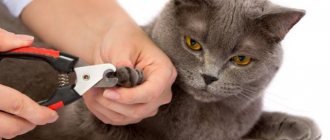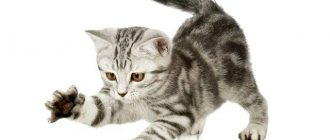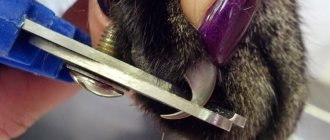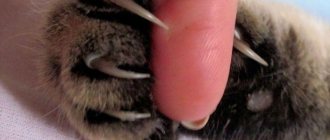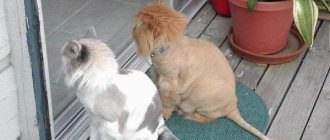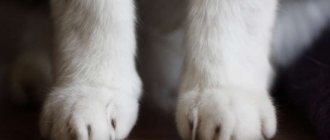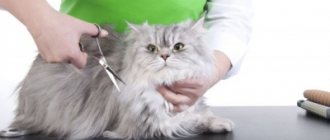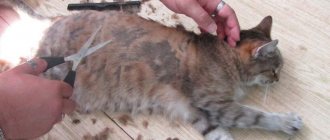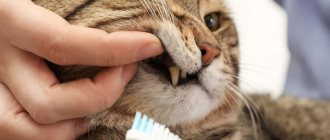What will you learn from the article?
- How to trim a cat's claws correctly?
- 8 tips on how to trim a cat’s claws How to prepare for the first procedure
- Nail trimming tools
- How often to trim a cat's claws
- What not to do
A cat's claws grow throughout their life and are continually renewed. To speed up and facilitate this process, cats need to sharpen their claws by scratching objects that are not always suitable for this. And during play, cats very often injure their owners with sharp claws.
Is it possible to trim a kitten's claws? The answer is yes. In this article you will learn how to trim a cat's claws.
Why trim your cat's claws?
The joy of acquiring a furry neighbor is often replaced by concerns about the animal’s behavior. If a cat has not been accustomed to a scratching post since childhood and is inclined to swing its paw at the owner’s hand, there is a risk of getting an unpleasant surprise in the form of frequent scratches. Trimming cat claws is necessary and can be done at home:
- If your pet has an increased interest in furniture, this can completely ruin a sofa, armchair, set, or even renovations.
- If the pet has an aggressive character and has repeatedly scratched and injured its owners, family members and guests.
- If your pet is participating in shows: show breeds (British, Russian Blue, Maine Coon) may be disqualified for having untrimmed nails.
- There are pathologies in which animals have deformed phalanges and claws that grow into the paw pads. In this case, trimming the claws is a necessary procedure.
IMPORTANT: claws are an important tool of feline nature. Animals use their claws to hunt, climb to surfaces, and defend themselves. Completely declawing a pet is inhumane and unsafe for the animal's future life.
Nail trimming is a safe and necessary procedure for indoor cats.
Why does a cat need a manicure?
The cat's hard, sickle-shaped claws, which grow and renew throughout its life, are its formidable weapon, as well as a useful tool that allows it to storm trees and other heights.
In their natural environment, animals have many opportunities to wear down their claws, making them easier to renew. At home, cats have no choice but to be satisfied with a scratching post, wallpaper, door frames, curtains, carpets and, of course, upholstered furniture, which, in their opinion, is simply created for sharp claws to stick into. Tearing soft surfaces is, rather, a pleasant pastime for a cat. It does not provide either grinding of the claws or their shortening, and the animal has to experience discomfort, accidentally clinging with “scratches” to all suitable objects. Sometimes the kitty cannot even free its paw on its own, and then plaintively cries out for help.
It is dangerous to play with a pet armed with long, sharp, curved claws. The first to suffer from them are, of course, children. Don't think that the main threat comes from the cat's front paws. The claws on the hind, pushing, paws, although they grow more slowly, are stronger and tougher. It is with these “daggers” that a pet that has played out can accidentally inflict the most dangerous and deep wound.
In short, regular trimming of cat's claws eliminates or minimizes many problems. This procedure will require patience on the part of the owner, and also a lot of time, because you need to do more than just trim the curved tips of the claws. You will have to follow a certain technique, know at what angle to hold the tool, how to ensure the safety of the “operation”.
Preparing for your first haircut
Trimming nails should become a familiar procedure for your pet from an early age. You should periodically pick up the kitten in your arms and, pressing slightly on the pads of its paws, allow it to release its claws, while simultaneously massaging its paws. Over time, when the kitten begins to calmly respond to manipulation, it will be useful to reward it with treats, thereby reinforcing the positive habit.
IMPORTANT: a kitten should have its claws trimmed when it is 2 months old.
Ideally, the pet should be indifferent to the procedure.
The procedure can only be carried out when the animal is in a completely calm state. It is strictly forbidden to use physical force and raise your voice at your pet, but it is still necessary to show persistence: there is a chance that the pet will begin to worry and break out.
Talk affectionately, pet and treat your pet, and enlist the help of someone who can hold the animal. Do not insist on the procedure if the cat screams loudly and breaks out, this is fraught with psychological trauma and severe stress. Be patient if you want to make bone trimming a habit in your pet's life.
At what age should a kitten's nails be trimmed?
Is it possible to trim kittens' nails? Yes, but not for newborns. Small cats do not know how to remove their claws. They are constantly released and spread out. They use marigolds from the first days of life, massaging their mother's nipple with their paws to stimulate milk synthesis. At first the claws are soft and short, then they begin to harden and by 6-8 weeks they leave the first scratches.
When can you trim a kitten's nails? Not earlier than 3 months. The plates harden completely by 6 months. By this time, the kitten can already be accustomed to the procedure.
Haircutting tools
First of all, to successfully perform a cat manicure, you need to acquire a tool. In specialized pet stores and veterinary pharmacies you can find all the equipment necessary for the procedure:
- Nail clipper-scissors. In appearance it resembles ordinary nail scissors, but with notches on the blade. It is in these grooves that it is convenient to insert a cat's claw so that it does not slip. The device allows you to quickly and evenly shorten claws.
- Trimmer in the form of a guillotine. The tool resembles pliers with a ring instead of blades. The trimmer is easy to use and very popular among experienced owners. Beginning cat breeders may have difficulty determining the length of the claw to cut.
- Nail clipper. The device is safe to use, as it has a locking system that prevents the blades from closing.
- Veterinary clinics and animal care salons use electric nail clippers, which are classified as professional tools.
Nail trimming tools
In a wide selection of cutting devices, the owner is often confused about how to trim a cat’s claws. If you have little experience in this procedure, then you should choose a nail clipper or scissors. The choice of tool also depends on the condition of your pet’s claws. If they are thin and transparent, then scissors or pliers will do the job, but if the claws are dense and thick, then a guillotine trimmer will be the best option.
At home, you can also use nail scissors or clippers to perform the procedure. In addition to the cutting tool, you will also need a hard nail file or emery block for correction after trimming. Just in case, you need to arm yourself with cotton swabs and 3% hydrogen peroxide.
What you need to shorten your nails
For the procedure of cutting a cat’s claws, you need to prepare a certain arsenal of tools and tools. Everything you need should be at hand so that you don’t have to be distracted by searching for the item you need at the most inopportune moment. The debut “operation” usually involves special troubles. They usually concern the selection of a suitable tool for trimming cat claws.
It is clear that kitchen and office scissors are not suitable for successfully carrying out a delicate procedure. As for the use of nail scissors, this too is questionable. Firstly, they are not very convenient to operate: the blades in such tools are not designed to cut a dense, round claw, which is why they constantly slip off. Secondly, for cats who do not want to freeze during the “operation”, the sharp tips characteristic of most nail scissors can pose a danger. For those who are absolutely confident in their skills, and at the same time their pets are distinguished by humility, it remains to remind them of hygiene. You cannot trim cat’s claws with “human” nail scissors. You should purchase your own tool for the animal.
It is most convenient to use special scissors - nail clippers, which are offered in specialized stores for animals and on the Internet. They are distinguished by a unique design with reinforced blade edges. Using nail clippers, your cat's hard claws can be trimmed quickly and painlessly. It is advisable to purchase a tool with rubber pads on the handles, since the palm often slips off smooth surfaces.
There are various modifications of nail clippers, so you can experiment before finally choosing the most comfortable option for you and your pet.
Nail clippers come in several basic models.
- Nail clippers-scissors. In its shape, the tool resembles ordinary scissors, but the blades are not straight, but curved at the ends. As they round, they form holes in the shape of holes with a sharp edge into which the claw is inserted. When the blades are closed, it is easily removed.
- Guillotine nail clippers. This tool, which is in great demand today, operates on the principle of the infamous invention of Monsieur Guillotin, used for beheadings. The cat's claw is inserted into a special hole, and the excess part, from the owner's point of view, is cut off with a blade. The mechanism operates a lever on a spring.
- Nail clippers. A convenient device with rubberized thick handles resembles a locksmith's tool. The claw is inserted into the gap between its cutting edges with sharp blades and is literally bitten off by them when the handles are squeezed. Most of these models are equipped with a special limiter, which allows you to trim the claw to a certain length.
- Claw grinders. This is a professional tool for groomers that can be used at home if you understand the principle of its operation. The battery-powered device is equipped with a tip covered with emery, that is, it is not intended for trimming claws, but for grinding them down. Many cats do not like such devices, probably believing that their buzzing is suspicious.
In addition to a nail clipper, for a cat “manicure” you will definitely need:
- cotton wool or cotton pads;
- disinfectants (hydrogen peroxide is best);
- hemostatic agents (hemostatic sponge, special powder, dry potassium permanganate).
Owners of especially fluffy cats may need a hair clipper to treat the area around the toes before trimming their nails.
For cat owners who perceive “manicure” as an execution and actively resist it, fixing overalls will help them cope with the task. They can be bought at pet stores.
In the set of accessories for trimming nails, many owners include a file or an emery block designed specifically for animals.
Age and purpose
Cats are pets that are often kept at home, so you need to know the basic requirements for caring for them. Since animals are wild and capricious by nature, the presence of sharp claws can be quite dangerous for others. To minimize risks, you need to be able to trim a cat's claws if the need arises.
There are the following reasons why this procedure is mandatory:
- keeping a cat exclusively at home;
- lack of significant activity in the animal’s behavior;
- assistance in grinding down claws if the pet cannot do it on its own;
- too violent and unbridled character, which threatens the health of others.
If in the first three cases the manicure procedure is desirable, then in the last one it is necessary to trim the cat’s claws, because anyone can get hurt, including children. The procedure for shortening the nail plates can be carried out on all four paws so that the cat does not feel discomfort, understanding the difference in sensations in front and behind, and is also completely harmless. If the pet does not show aggression, then trimming and filing the claws on the hind legs can be omitted.
It is not recommended to do this procedure too often, as this can negatively affect the cat’s health. There are also certain age limits when it is worth starting such procedures in order to accustom your pet to them and not have problems with it in the future. The optimal period would be the age of two to three months, when the claws have already become stronger and can be cut off, and the pet is still small enough to protest, but is quite capable of gradually getting used to the manicure.
Carrying out similar actions for smaller kittens is harmful, since their claws are still too tender and you can cause pain to the pet by cutting them too much.
You can cut the nail plates of a cat or kitten only if you have some experience or knowledge of how the process itself should be carried out correctly. The first time is always the most difficult, both for the cat and for the owner, so it is important to prepare mentally and create all the conditions for the work to be carried out successfully. To keep the kitten from getting nervous, you need to pet it, talk to it, and treat it to something tasty. The procedure will no longer be scary and unpleasant for the animal when it feels safe and expects a reward after the manicure is completed.
Once the procedure has become habitual for your pet, it is worth deciding on its frequency so as not to worsen the condition of the claws and not to overdo it with shortening them. For each cat, the number of such sessions may differ, which is explained by individual developmental characteristics, activity level and age. The optimal norm is to trim claws once a month.
If we talk about kittens, then they are actively growing not only their bodies, but also their nail plates, and therefore they will have to be shortened 2 times more often.
Which tool is better to use?
When you come to a pet store, your eyes widen. There are a number of different nail clippers to choose from:
- Scissors are somewhat reminiscent of regular scissors, but have a rounded notch on the inside of the blades. One of the cheapest options.
- Guillotines - with a large hole into which the claw is placed and cut to the required length. Suitable for large breeds. It will be difficult to use only at first.
- Secateurs - similar to garden pruners. Very easy to use and has limiters for complete safety.
- The file is the same as for a person.
- A grinder is an electrical device with an abrasive surface. It is this that allows you to grind down your claws. It works quite quietly and does not cause panic in animals.
Caps are also provided to prevent damage.
Each owner has the right to choose what is convenient for him to work with. Main criteria: the accessory fits comfortably in your hand, does not slip and is made of high-quality steel without nicks. Otherwise, injuries are inevitable.
How to prepare for the procedure
The owner must know how to prepare for pruning. Most pets initially resist pruning with all their might. It is important to properly prepare your animal. It is better to choose a time when he is relaxed and in a good mood. You need to start with a paw massage so that the pet does not feel discomfort. Attention switches to other activities and objects.
In the first months, the kitten experiences fear, fear and even irritation. It can break free and run away, and if held by force, it can even bite or scratch a person.
You should not use physical force, as it is necessary to convince your furry pet that this procedure is absolutely safe for him, that he has nothing to be afraid of. Trimming should be done regularly; the animal will gradually get used to it.
Over time, a habit will appear, and to make this happen faster, you can use encouragement in the form of something tasty. In order for pruning to be taken calmly, you should not expose your pet to stress. The owner should talk to him affectionately and stroke him. If the cat is too scared, it is better to postpone the procedure.
How much does nail trimming cost at a veterinary clinic?
Experts know firsthand how to trim a cat’s claws. A veterinarian or professional groomer will assess the condition and perform a haircut with special scissors and sterile instruments. If necessary, the cat will be given a sedative and will not receive any physical or mental harm.
The cost of the procedure differs in different clinics. In Moscow prices vary:
- regular haircut – from 300-500 rubles;
- pruning under sedation – from 2000 rubles;
- manicure and installation of soft nails – from 1400 rubles.
In the regions, prices may differ slightly from those in the capital. The procedure is more expensive in private grooming salons, with comprehensive preparation for exhibitions.
Trimming claws is a necessary procedure that will not cause discomfort to the pet if the kitten is accustomed to it from an early age and done correctly. It is easy to carry out at home, finding an individual approach to your pet.
How to trim a cat's claws yourself?
Preparation begins at the moment when the animal does nothing: does not eat, does not sleep, does not play and does not lick itself. Take your pet in your arms, talk affectionately and communicate. Lightly touch the paw pads, massage them, while trying to distract your pet's attention. It is advisable to enlist the help of someone whom the cat knows and trusts.
- Place your pet on a stable surface.
- Take the paw, gently massage and press on the pads, do this with each paw.
- If your pet reacts well and doesn’t break out, give him a treat.
Below you will learn how to trim a cat's claws using scissors and a nail clipper at home.
How to properly trim a cat's claws with scissors at home
Prepare:
- Scissors (blister)
- File
- Cotton pad
- Hydrogen peroxide
Before the procedure, wash your hands, clean and disinfect instruments.
The pink part is the vessels and pulp
- Carry out the procedure in a room with good daylight.
- Sit comfortably and place the cat on your lap, stroking and calming your pet.
- Take the paw in your hand, massage it, and as soon as the cat releases its claws, start trimming.
- After trimming your pet's claws, treat them with a file so that the animal does not cling to surfaces.
The photo shows a diagram of how to properly trim a cat's claws without damaging the pulp.
IMPORTANT: take special care if the cat’s claws are black - leave extra length for safety.
Do-it-yourself haircut with a nail clipper
A nail clipper allows you to safely trim your nails to the desired length. Using a nail clipper, it is almost impossible to accidentally injure an animal, but you should cut carefully so as not to touch the blood vessels.
Prepare:
- Claw clipper
- File
- Cotton pad
- Hydrogen peroxide
Before the procedure, wash your hands, clean and disinfect instruments. Next, follow the familiar instructions:
- Choose a well-lit room.
- Sit the animal on your lap, calm and stroke it.
- Allow your cat to release her claws by gently pressing on the pads of her paws.
- Carefully guide the movements of the nail clipper at the correct angle so that after the procedure the claw resembles an “arrow”.
You can leave extra length to be on the safe side.
When and how to accustom a cat to trim its claws
It is advisable to accustom your cat to trimming its claws as a child. Then you can expect that, having matured, she will behave quite humbly during the procedure. But until the kitten is at least a month old, there is no particular point in such science. The baby’s “scratches” are still tiny and small, they are easy to damage, and in the first weeks of life he mainly sleeps and eats. Then you can carry out 2-3 symbolic procedures to prepare the cat for a full “manicure”. It can be done when the pet is 3 months old. By this time, the claws will noticeably harden and become sharp.
It is more difficult to train an adult cat to have its nails trimmed. However, over time she will get used to this manipulation, although she will not behave like a lady in a nail salon offering her hand herself. Regardless of the age of the animal, it will have to be persuaded to trim its claws, forgetting about brutal coercion. If the pet hisses and breaks away from your hands not formally, but demonstrating real anger or extreme fear, the procedure must be postponed.
First of all, you need to choose a time suitable for the “operation”, when the cat is in a complacent, calm state. This is how he usually looks after sleep or after a substantial portion of food. The purr needs to be placed on your lap, caressed, started a conversation and gently grabbed by the paw. Massage it, quietly approaching the pads. Then press down lightly so that the claws come out.
If you yourself do not have experience, take a good look at the claw to understand where the border of the pulp containing the blood vessel and nerve lies. Under no circumstances should you offend her. Trauma to the pulp will cause pain to the cat and may result in bleeding. You can only cut off the curved transparent part of the claw, stepping back from the pulp by 2 mm. Inside the light claw, the pink pulp is clearly visible, but inside the dark claw, the problem area is almost impossible to determine. You have to shorten the claws by touch, cutting them 1 mm 2-3 times.
While stroking the cat's pads with one hand, take the nail clipper with the other. If the cat is interested in the tool, let him sniff it and make sure that it is not an enemy. You can start trimming if the cat favorably tolerates manipulations with its pads, allows you to expose its claws, in a word, expresses trust in you with its appearance.
Alternative Methods
If your cat categorically refuses to get a pedicure and it is inconvenient to take him to the veterinary clinic every month, you can consider alternative methods:
- Anti-scratch. Special overlays (caps) prevent damage to the furniture, but it is uncomfortable for the animal to walk, and the horny plates still grow and need to be cut off.
- Onychectomy or soft paw surgery. A difficult procedure for the animal, during which part of the cat’s fingers is taken away. Animals' paws become deformed, they lose coordination, and suffer from pain. Condemned by many veterinarians and breeders. In a number of countries the operation is prohibited.
What can you use to trim your cat's nails?
The market for professional cat grooming has become so vast and popular that it has become difficult to know what to choose and use. Manufacturers offer nail clippers of various designs and types, but you should pay attention to quality and sharpness.
- Side claw clipper. From Hanna Nursery recommends this type.
- Guillotine claw clipper.
- Nail clipper-scissors.
- Grinder is a tool with a grindstone (diamond coating).
- Nail file.
Regular human tweezers, clippers or scissors are not suitable for trimming nails.
There are owners who consider declawing operations normal. This is a barbaric operation, why you can’t do this - it removes the phalanx of the finger along with the claw, as a result - the animal becomes disabled, both physically and psychologically, balance when walking is impaired, it hurts the cat to step on its paws, even after many years, to participate Such animals are not allowed in exhibitions. I wonder how these owners would live without one phalanx on each of their fingers?
It is common to use soft claws. A less barbaric activity, but still. To fix the caps, glue is used on the trimmed claws. Manufacturers claim that this is the best alternative to declawing, is safe for cats, does not affect the cat’s behavior, and much more blah blah blah. It’s hard to imagine any cat that would be glad that she had plastic hooks attached to her, her movements were constrained, how will her pet scratch herself and walk?
We humans must be responsible, take care of those we have tamed.
How often to trim nails
Experienced breeders who are interested in how often to trim a cat's claws advise trimming them as they grow. Typically this procedure should occur once every 10-14 days. But this is a common opinion, and in fact, the frequency of claw trimming will largely be determined by third-party factors:
- personal characteristics of the body (speed of nail growth);
- color of the nail plate (light nails grow faster than dark ones);
- activity of the cat (more frisky animals, often playing in the apartment or spending time outside, take care of the sharpness of their claws, regularly sharpening them, as opposed to their lazy relatives, who often spend time half asleep).
- No one can say with certainty how often to trim a cat’s claws, so in each case it is necessary to determine the frequency of trimming on an individual basis.
It is a common belief that the claws on the hind paws do not need to be trimmed. You should not check the correctness of this statement on your own furniture.
If a cat is participating in an exhibition or is about to be bred, it is imperative to trim its claws the day before.
General recommendations for the frequency of nail trimming
- Animals leading an active lifestyle, who run a lot, play and use a cat scratching post, should have their nails trimmed no more than once a month or even less often.
- Old or lazy cats that move little and mostly lead a sedentary lifestyle should have their claws trimmed twice a month.
What to do if the animal is not given
To trim the claws of cats that categorically refuse this procedure, they use fixing overalls. They provide access to all limbs, but do not allow the pet to move freely.
At first, it is advisable to carry out the haircut with an assistant who will hold the animal. If the cat meows loudly and struggles, take a break. Let her rest and calm down for a while, then you can try again.
Important. You should not swear or shout at a cat if it resists while trimming its claws. Aggression from the owner will only frighten her. In the future, the pet will try by all means to avoid the unpleasant procedure.
What should you do if your cat doesn't want her nails trimmed?
Not all cats like having hygiene procedures performed on them, especially nail trimming. Some of them may be nervous, grumble, wag their tail threateningly, and some even strive to scratch or bite their owner. Therefore, if a cat shows particular aggression during a haircut, then you need to follow certain rules and recommendations in order to carry out the procedure safely:
- The grooming procedure should be done at a time when the cat is most calm and peaceful.
- Before trimming a cat's claws, you can swaddle him - this will save the owner's time, and he will remain without scratches or bites.
- You need to constantly pet the cat and speak kind words to it to relieve excess stress and aggression.
- Claws need to be trimmed when the animal has completely released them from the pads.
- After trimming the cat's claws, you need to give it its favorite food or something tasty.
How to trim a cat's claws correctly?
Try as early as possible to accustom the kitten to such a procedure that is obscure to him, such as cutting his claws (nails). Also, don’t forget to accustom your kitten to the scratching post and make it yourself.
Stroke his paws, gradually moving to the pads, lightly press on the pads until claws appear. Such simple exercises should be done as often as possible, and then trimming your pet’s nails will become quite commonplace.
It is good if during the procedure the kitten is sleepy or at least calm.
Don't try to catch him while playing and start cutting his nails.
There is no need to forcibly “break” the kitten and try to forcefully get your way. True, there are specimens that, despite all efforts, cannot get used to hygienic procedures.
Then I advise you to be sure to swaddle the cat so as not to injure yourself or the kitten while trimming its claws.
I made a video on how to trim a cat's claws at home.
What to do if blood comes from the claw
Rarely does a haircut succeed without incident - either the cat twitched, or the hair was too long. The main thing is to be prepared for anything. What do veterinarians say?
At home, only hemostatic powder or dry potassium permanganate are available. She can only stop the bleeding on her nails, but not on her skin - it risks a chemical burn.
In all cases, not excluding the above-mentioned bleeding, veterinarians are of the opinion that the care was professionally provided.
It is better not to carry out such procedures on your cat yourself - or first get advice and advice from a veterinarian.
Possible dangers
Troubles during the nail trimming procedure usually await rebellious cats that squirm on the owner’s lap. In this case, both participants in the process can be injured by the cutting or grinding tool. A tragedy will probably not happen, and light bleeding wounds can be healed with the help of antiseptic and hemostatic agents. The danger zone is the animal's eyes. When a cat begins to show excessive fidgetiness, the tool, especially if it is pointed nail scissors, should be put aside for a while.
Traditionally, the main threat to the animal is the carelessness or inexperience of the owner, and it is associated with injury to the pulp. If you overdo it, hitting the vessels with a claw clipper, blood will inevitably appear. There is no need to panic when you see her. It is necessary to disinfect the injured claw with hydrogen peroxide, and then treat the wound with a hemostatic sponge or hemostatic powder. If you use dry potassium permanganate, make sure that it only covers the damaged area. Contact of this drug on the skin may cause burns.
Typically, bleeding can be stopped within 5 minutes. If for some reason the bleeding cannot be controlled, you will have to take the injured pet to the veterinarian. You will also need to visit a specialist if you discover that the fifth claw on one of the front paws has begun to grow into the pad. This is a fairly common occurrence. The claw, located slightly to the side of the other four fingers, does not experience any impact at home and does not even touch the floor, so it grows the fastest.
Is it necessary to remove claws?
Don't remove the claws! During onychectomy, not only the plate is removed, but also the phalanx of the finger from which it grows. Only a very young cat can survive surgery without consequences, and the procedure itself carries many risks.
Among them:
- blood loss;
- infection;
- nerve deformation;
- disturbance of gait, balance, coordination due to the fact that the pet will be forced to step on the pad and not the fingers;
- deterioration of character due to the fact that the cat feels vulnerable and unable to defend itself.
Instead of removing the plate, trim it regularly, use a scratching post. If you don't have time to trim, buy soft silicone covers for cat nails. As the plates grow, they come off (after 2-4 weeks), and the procedure must be repeated. During this time, the claws become soft and dull, and therefore the cat will not be able to damage the furniture with them.
Alternative methods
It is not necessary to cut your cat's claws every time; there are other methods to shorten them or remove them completely.
The methods are chosen independently, depending on the conditions of the animal’s keeping and individual preferences.
Surgical method of removal
The procedure is indicated only for cats that live in an apartment and do not go outside. Even if in the summer the animal goes to the country with its owners, surgical removal is not suitable for it. This is due to the fact that the animal may remain defenseless against other aggressive cats.
Surgery is chosen only for young cats, because the animal needs to learn to do without claws as quickly as possible and the healing process is better in this case. Any chronic disease in an animal may be contraindications.
Covers for claws
An alternative to a haircut can be anti-scratches. They are silicone caps made of soft plastic. They are attached to the claws using a special glue, which is absolutely harmless and does not cause discomfort to the animal.
The uniqueness of this device is that the cat will be able to continue doing its favorite thing - sharpening its claws on furniture, but there will be no destruction, and its instincts will be preserved. In this case, the cat will not even be able to injure the child.
Why cut your hair?
Some argue that you should not trim the claws, because the animal will need them. Others are absolutely unhappy with the prospect of walking around with scratches and living in an apartment where the furniture and walls are torn.
It is believed that cats that go for a walk in the fresh air wear their claws down on asphalt, stones and tree bark.
For cats who are always at home, they can be replaced with a scratching post. However, many people prefer sofas, wardrobes and wallpaper.
Cats have four claws on their hind legs, and five on their front legs. You need to cut them off to prevent ingrowth.
Now you know how to trim a cat's claws correctly. As you can see, even an inexperienced person can do this. Any caring owner can easily cope.
How often should the procedure be performed?
- Sedentary lifestyle or illness. If the animal is not very active, then it cannot sharpen its claws on its own.
- Room contents. Pets are unable to properly care for their nails. If a pet has the opportunity to walk outside, then it is able to cope with its problem on its own.
- If you have small children. A child and a cat do not always get along with each other. Often the animal can release its claws. Therefore, it is worth regularly giving your cat a manicure.
- Wash your hands well and sterilize the instrument.
- Hold your pet firmly and press on the paw pads until the claw appears.
- The device must be directed at right angles to the desired nail (direction from top to bottom).
- If the animal has a light-colored claw, then it needs to be trimmed within 1-2 mm of the pink area. For cats that have pigmentation, trim 1-2 mm from the tip of the nail so as not to damage the capillaries. If the pet has dark claws, they are trimmed in stages to avoid bleeding.
- Trim the claw in one motion.
- Sand the cut area with a nail file and treat with an antiseptic.
You should not keep your cat in an awkward position for a long time, as this can make her nervous. It is important to know that if a capillary was touched during the procedure, then a bandage or cotton wool moistened with hydrogen peroxide must be applied to it. In addition to this remedy, you can use Chlorhexidine. If you cannot stop the bleeding, you should contact your veterinarian. But usually such manipulation, if you have the proper experience, is quick and painless.
Owners of the Persian or Siberian cat breed will need a special hair clipper. These animals have a lot of hair near their paw pads. They prevent safe nail trimming. If your pet is frightened by the noise of the device, you can cut the hair using scissors. After the procedure, you can treat your pet with his favorite treat. Also, the animal must be praised for its exemplary behavior during the procedure.
On average, a domestic cat needs trimming once a month. If a young animal lives in the house, then a haircut should be done once every 2 weeks. At this age, claws grow faster than those of older cats. You should not skip this procedure, as the pet will get used to it very quickly and the owner will have to accustom him to the unpleasant manipulation again. If an animal is to compete in a competition, its claws must also be trimmed. Otherwise, the cat may be excluded from the competition.
Here you should take into account the individual characteristics of each pet, for example, the rate of growth and lifestyle. Active cats grind off some of their claws on their own, but lazy sofa kings do not. Consequently, the latter need manicure procedures more often. Observe your cat and choose the optimal trimming frequency.
The cat's claws are trimmed
The frequency of performing this procedure is strictly individual. The owner of the animal must find out how quickly the cat’s claws grow and create an individual schedule for the procedure. Some cats go through it no more than once a month, others have to go through a haircut 2, and sometimes 3 times a month.
If a cat not only lives at home, but also often walks outside, then, most likely, his claws will have to be trimmed much less often. They will wear off naturally. But not so effective that you can completely abandon the haircut.
The claw has an outer hard shell, under which the pulp is hidden. It contains blood vessels and nerve endings. The pulp occupies most of the claw. It cannot be damaged. The keratinized part is cut off. This is just a few millimeters at the very tip of the nail.
To avoid mistakes, you must first examine your pet’s claws in the light. They are well translucent and thanks to this you can see the border of the pulp of the keratinized tissue. It is along this border that the claws need to be trimmed.
Naturally, before starting the procedure you need to prepare the appropriate tools.
- Special scissors called nail clippers. They are made of durable stainless steel and are specially designed for this purpose.
- Guillotine trimmer. It is better for beginners to use this device. It is very easy to use and completely safe for your pet.
- Hard nail file. You can use a regular nail file from a manicure set.
All instruments must be disinfected before use. No need to boil. It is enough to treat the tools with alcohol.
It would also be useful to prepare cotton pads, hydrogen peroxide and an antiseptic - chlorhexidine. These items will come in handy if the owner touches the pulp.
In addition to the four working claws, with which the cat catches and holds prey, and tramples on its owners (by the way, massage-stomping is another reason to trim your pet’s claws on time - otherwise a pleasant trampling threatens to turn into a painful ordeal), the animal also has a fifth claw, which must be cut off.
Due to anatomical features, namely its location too high on the paw, the fifth claw cannot be sharpened naturally by walking on the ground or asphalt. In addition, it is located on the inside of the animal’s paw, so it cannot be ground off by wood or scratching posts.
The fifth claw is an invisible front of work that must be done before or after trimming the main claws. The main thing is not to forget about its existence, since the grown fifth claw can cause pain to the animal when walking.
Claws should be trimmed as they grow, approximately once every two to three weeks. This procedure should not be skipped, otherwise cats will quickly wean themselves off it and the owner will have to re-accustom the cat to trimming its claws.
An exception may be in cases where the pet is sick or is under stress.
Owners whose cats participate in exhibitions or competitions before such an important event must trim their pet’s claws, otherwise it may be disqualified.
How often should I trim my hair? It all depends on the individual characteristics of the cat. Experts in the field of felinology strongly recommend accustoming a meowing creature to this procedure from the age of a kitten. Then in “adult” life the pet will treat her more calmly.
You can accustom a baby kitten to a haircut after 1 month of life. Let us warn the owners: “Is it possible to trim a cat’s claws at such a young age?” It is possible and necessary! After all, the sooner a pet gets used to using a nail clipper or scissors, the faster and more painless the grooming process will be in adulthood. But it is up to the owner to clearly determine at what age a cat can be declawed through circumcision. And if the cat is too weak by 4 weeks of life, it is better to abandon the procedure for a while.
There is no point in carrying out the procedure earlier than 1 month. Firstly, the claws of newborn kittens are still too tender, unable to cause pain to either the mother cat or a person. Secondly, kittens under 1 month are not yet so active and spend most of their time on a cozy bed, drinking mother's milk and dreaming. Thirdly, the baby can easily damage the blood vessels located in the thickness of the small claw.
If for some reason an adult cat appears in the house, you can accustom it to grooming too. True, with a mature individual it will be a little more difficult (the cat can break out, hide, bite or scratch the owner).
- Take care of hand and instrument hygiene;
- Calm down, talk to the cat quietly and calmly;
- Place the purr in your arms, taking the tool (claw clipper) in your working hand;
- With your free hand, grasp the cat's paw, pressing on the pads of the fingers so that the claws extend to their full length;
- Holding the nail clipper perpendicular to the claw, cut off its curved tip without affecting the blood vessels;
- If necessary, file the claw with a nail file;
- Trim the claws on all the cat's toes;
- If the pulp is injured, treat with hydrogen peroxide;
- Praise your patient friend by giving him a treat.
How to trim a cat’s claws: getting ready and carrying out the procedure correctly
Inexperienced owners think that trimming a cat’s claws is a difficult and unnecessary task. There may be some justice in this approach, but a responsible owner must have certain skills, and painless nail trimming is one of them.
Do cats need manicures?
Nobody cuts the claws of wild cats, but in (civilized) zoos even lions get a manicure, and the claws are not only trimmed, but also filed. This procedure is mandatory and is explained by a number of reasons. Cats' claws grow constantly, that is, if they are not worn down or trimmed, then problems cannot be avoided.
Another argument emphasizing the uselessness of the procedure: in villages and cities, many cats live without manicure and maintain their claws in order on their own. Yes, it's true, most animals know how and enjoy caring for their claws. A cat's daily diet includes cleaning and sharpening its claws.
Cats whose skills have been dulled need meticulous care. For the most part, this applies to artificially bred breeds. Some animals have a genetic predisposition to rapid growth of claws, that is, the cat simply does not have time to wash them, even though she leads an active lifestyle.
Let’s make a reservation right away: if you trim a cat’s claws correctly, there is nothing dangerous or painful in this procedure. Moreover, many pets need (!) their nails trimmed to prevent ingrown nails. Claws that are too long bend, and their tips become like sharp hooks. The cat knows how to retract its claws, but to a certain length, and if these hooks look out of the sinuses, they cling to upholstered furniture, the owner’s clothes and carpeting. Tights and marks are not so bad, the main thing is that the pet experiences discomfort, walks unsteadily, and if he pulls his paw too hard, he risks injuring his finger.
If you notice that your cat has begun to dig at the floors and walls (usually at night), this is a clear sign that her nails are too long.
Unlike some dogs, all mustachioed tabby dogs have fifth toes on their front paws. These fingers are mobile and functional, and the claws on them serve as an additional tool. The claw on the fifth toe does not wear down naturally. In most outbred cats, the claws on the fifth toe only grow to a certain length, but there are exceptions. A claw that is too long curls toward the paw, pricks and pierces the skin. It is easy to imagine how quickly a wound will become infected.
Conclusion: whether your cat personally needs a manicure is up to you to decide, but according to general rules, nail trimming is a mandatory grooming procedure.
It would be convenient if with each animal the owner was given instructions - what to feed, when to bathe, how to play... in practice, each owner gains skills through trial and error. Based on the experience of owners and veterinarians, we can conclude that the frequency of claw trimming depends on a number of factors, and here are just some of them:
- Lifestyle – a cat that goes outside has the opportunity to actively grind its claws. Lazy couch cats need more frequent manicures.
- Genetics – Some pets are prone to extremely rapid nail growth.
- Balanced diet - if the diet lacks microelements, claws grow more slowly.
- The presence of cat accessories - scratching posts, special rugs and posts with which the cat plays, this is a tool for grinding down the claws.
- Pigmentation - it is believed that light claws grow faster than dark ones.
The rate of nail growth for each cat is individual and depends on a number of factors. Shearing is carried out strictly as needed, on average once every 2–4 weeks.
A word of caution - don't trim your pet's nails just for convenience. Unfortunately, some owners often trim their cats' claws out of fear for the integrity of the furniture or injury. It is better to think about material damage before getting a cat, and if you are afraid of serious scratches, you need to raise a pet.
There is an alternative, although not the best, but quite adequate - caps for claws. Silicone caps are attached with glue and serve as a temporary measure, for example, to ensure the safety of a child while meeting a cat.
Tool selection
A professional “with a full hand” can easily trim a cat’s claws with ordinary scissors, but for beginners it is better to use a special nail clipper. The problem is that the structure of a cat's claw is not as simple as that of a dog or a human. The finger and claw are a complex mechanism that includes not only joints and ligaments, but also large blood vessels. Thanks to such a complex device, tailed animals can hide and extend their claws at will.
Without going into the depths of cat anatomy, we can say that the claw consists of two parts: keratinized and living. You can cut only the tip, and if you catch the living part, you will not be able to do without bleeding. In addition, when a living part is injured, large nerve bundles are excited, and the cat experiences severe acute pain. If it happens that the claw was cut too short, the cut should be treated with antibacterial solutions until it is covered with a layer of keratinized tissue.
To carry out the procedure at home, veterinarians recommend using a specialized instrument. The experiences and reviews of owners vary greatly, as everyone chooses a more convenient accessory and approach for themselves. So, if you are going to trim your cat’s claws yourself, you can use:
- Using stationery scissors - as mentioned above, if you are not experienced, there is a high risk of damaging blood vessels.
- Nail clippers are a safer tool, which, although not intended for animals, will allow you to trim and blunt only the tips of the claws. When using tweezers, you need to hold them perpendicular to the claw; if you press at an angle, the nail plate may crack.
- The guillotine is the most suitable tool for a beginner. The full name of the accessory is a guillotine-type trimmer. The advantage is that the claw is trimmed in one motion along a precise line. It is important that the trimmer is of high quality, since cheap accessories quickly become dull.
- Veterinary tongs are a hybrid of manicure tongs and a guillotine; they are convenient because they have handles that fit well in the hand.
- Special scissors (clave clipper) - they look like stationery ones, but at the ends of the blades there is a clip that carefully clasps the tips of the claws.
For the procedure, you need to prepare a first aid kit, at least cotton swabs and a solution to stop bleeding. No one is immune from mistakes, and if the claw is damaged, help must be provided quickly and competently.
In any large pet store you will find many models of accessories, but the mechanism of action for most of them will be similar - guillotine. When choosing such a tool, it is recommended to sharpen the cat’s claws after trimming with a special file or whetstone. If you buy a file in a regular store, choose a dense one, with a fine cross-section, but high rigidity, since cat claws are much harder than human ones.
If you are afraid of hurting your cat, it is better to entrust the first procedure to a veterinarian.
You can take your pet to the clinic or have it groomed at home. In any case, in experienced hands, your cat will get a manicure in literally 3 minutes.
Preparatory activities
Some owners are simply forced to take their cat to the doctor or to a nail trimming salon. The fact is that not every adult purr will allow its claws to be trimmed. On forums people often ask for advice on how to trim a pet’s nails if it breaks out or bites. Hypothetically, there are two options: give the pet a sedative and take advantage of his calmness, or accustom the cat to the procedure. Naturally, the first option is acceptable only if the situation is urgent.
Accustoming a cat to the grooming process should begin from childhood. There is no need to trim your kitten's claws, but it is necessary to familiarize him with the tool and the process itself. Repeat the algorithm when you have a free minute:
- Take the baby in your arms, stroke it and voice your intentions: “Now we’ll trim the claws, don’t be afraid.” Try to speak softly but confidently, don’t worry, your pet will feel it.
- Place your baby on the table and move the tool that you will use to trim his nails in the future. The baby will be interested in the accessory and needs to be encouraged.
- When the kitten sniffs the nail clipper and stops paying attention to it, pick up the kitten's paw.
- Click on the pad to reveal the claw. Touch it with the coterez. Repeat with all fingers and praise the kitten for each calmly accepted touch.
- When the previous point does not cause embarrassment, click the nail clipper next to the claw after making contact. Your baby will probably be scared the first time, but your praise and reassurance will calm him down.
Training an adult cat follows a similar algorithm, but there is some difficulty. A kitten is happy to do any activity together, even something strange, but you need to train an adult cat by adapting to its mood. If your pet is irritated, and you come at her with an incomprehensible clicking thing, she is unlikely to perceive the training process as a positive activity.
The procedure itself is not as complicated as it seems, but it requires attention and caution. Separately, it is necessary to say about cats with dark claws. The richer the pigmentation, the less visible where the living part of the claw begins. Try shining a flashlight on the claw; if that doesn’t help, contact a professional; don’t cut it at random. If you don’t have the opportunity to see a veterinarian, and “you need to do something” with your claws urgently, use a nail file.
Try to keep it clean. At a minimum, wash your hands and sanitize the instrument, even if it has just been taken out of the package. There is no need to treat the claws, but if your cat goes outside, it is advisable to wash its paws. Have clean napkins, sponges and a towel on hand. For the first procedure, we recommend preparing a first aid kit for yourself: sponges, brilliant green, bandage, cotton swabs.
Tip: the cat will be calmer if she understands what is happening, so the claws on the hind legs are cut after the front ones.
Be gentle but confident; your hands should control the cat's movements. If the pet pulls its paw at the wrong moment, the guillotine will hit the air, but if the claw is deeper under the blade, trouble will happen. Both of your hands will be busy, one will have a tool, the other will have a cat's paw, so for the first procedure it is better to enlist someone's help.
When you press on the pad of your finger, the claw is completely exposed. Examine it from the side, so you will accurately mark the border beyond which the vessels are located. The pink, live area contains nerve bundles, so if you accidentally damage the claw, the procedure should be stopped. The cat will be in pain and it will most likely not be possible to trim the remaining claws without harm. Some owners advise cutting all the nails at the beginning, and only then filing them.
Trim only the tips of the claws, that is, you need to leave at least 2 mm of keratinized tissue between the cutting line and the living part of the claw. Immediately after cutting, sharp corners will remain in the place of the cuts, which are rounded off with a sanding file. Run your claw over a napkin with a tenacious structure and ensure that there are no burrs on the claw. Was everything successful? Praise your pet and move on to the next claw. Take it step by step. If the cat becomes nervous, stop the procedure. There is nothing wrong with continuing your haircut the next day, but the negative emotions associated with the procedure are quite difficult to overcome.
The cat needs to be praised after each successfully trimmed claw, even if it twitches, but bites and scratches need to be stopped - that is, stop, straighten the cat and try again.
What to do if your cat is aggressive?
The main problems arise when you need to trim the nails of an aggressive cat. Let us immediately make a reservation that in such a situation there is no place for self-confidence, since an angry pet can cause serious injuries. The first thing you need to do is find an assistant, or better yet two. One person will hold the cat, a second will trim the claws, and a third will manage the emergency first aid kits.
So, we take it as an axiom that a cat needs to trim its claws, even if it doesn’t give in, hisses and bites. A method that has been proven over the years and by thousands of owners involves using a small, durable (sports) bag. The purpose of the bag is that paws can be placed in it, the claws on which are not cut. If you have a strong and dexterous helper, you can wrap the paws in a towel.
Before the procedure, the animal needs to be given half the dose of any veterinary sedative, because our goal is to accustom the cat, and not to cut its claws once and forget about it. Your assistant takes the cat by the skin on the shoulder blades (scuff) with one hand, and with the other holds a bag, towel or fold on the cat's lower back. At this stage, the main thing is not to scare the animal even more, because the pet understands that you are planning something terrible.
Try to act quickly and confidently, but do not forget to talk to the animal. If necessary, divide the procedure into several approaches so that the pet can rest. If the cat loses its temper and starts attacking you, it needs to be isolated in the room for 10–15 minutes, and the procedure should be continued in the veterinarian’s office. It’s mysterious, but true - when a veterinarian trims a pet’s nails, there is practically no resistance. Apparently, the reason is that the animal is in an uncomfortable environment and in the hands of a stranger.
A small fluffy kitten in the house is not only a great joy, but also a huge responsibility, because the pet needs careful care. And, if most cats perceive procedures such as bathing and brushing favorably, then trimming claws turns into a real problem not only for animals, but also for their owners. Let's try to figure out why you need to trim your cat's claws, whether it can be done at home, and what tools are needed for this.
How to properly trim a cat's claws at home, and is it worth doing?
Maintenance and care
maintenance and care
How to trim a cat's claws correctly? Do cats have their claws trimmed at all? This question occupies almost every owner. It is especially relevant for those whose pet has a habit of tearing up furniture upholstery.
Nail trimming: necessity or fashion trend?
It’s a completely different matter for an animal that does not encroach on the furniture and hands of its owner. “Why trim a cat’s nails if she doesn’t scratch?” - many people think. In fact, such a procedure is often needed not so much by the owners as by the furry purrs themselves. Their claws grow throughout their lives. If the animal does not have the opportunity to grind them down naturally, then the claws curl and dig into the paw pads, injuring the delicate skin.
A claw that is too long can get caught in a curtain or bedspread. As a rule, the animal cannot get out on its own. At best, the owner will free him. But it also happens that in an attempt to escape, a cat cripples itself, literally pulling the claw out of its “finger.”
In some cases, you can avoid an unpleasant procedure by buying your pet a scratching post or simply bringing a suitable board into the house. But these half measures do not always help.
Rules for cutting nails
Many people are concerned about whether a cat can have its claws trimmed? After all, if you think about it, they are the animal’s natural defense. Moreover: during the procedure, most animals struggle so much that there is a real risk of injury. Veterinarians are unanimous on this matter: it is necessary to trim claws, but it must be done correctly.
- The main thing to remember is that you cannot use either the tools from the manicure set or ordinary scissors. They are designed for a different nail shape, and the cat's claw can be injured. There are special devices - nail clippers. They are produced in two types: standard nippers and guillotine-type nippers. Both are easy to use, so the choice depends entirely on your preferences.
- In the part of the claw closest to the finger there is a blood vessel - the pulp. If you catch it, the animal will experience severe pain, and a drop of blood will appear on the cut. The result may be inflammation and infection of the wound, not to mention the fact that the next time the cat will desperately resist the haircut. Take the claw and look at it carefully against the light. You will clearly see a pink vessel and a whitish, transparent part with a depression in the middle. It is this that will need to be shortened.
- Some cats have black claws. In this case, it is almost impossible to determine where the live part begins. Therefore, it is better to cut off only the very tip.
- Don't forget that there are five toes on the paw: four on the pad and one at the back. It also needs to be trimmed. Moreover: even for cats that spend most of their time outside, it needs to be shortened from time to time. The fact is that it is practically not used and, accordingly, does not wear off even in the most active animals.
- There is no clear answer to the question of how often to trim a cat’s claws. It all depends on the growth rate of the horny plates. As a rule, the optimal interval is from 2 weeks to 1 month.
- Although the process of claw trimming is completely safe, not every cat needs it. For an animal that lives in a private home and spends a lot of time outside, claws are vital. Without them, they will not be able to climb a tree or protect themselves from a tailed rival or a dog. And a meeting with a rat without natural cat weapons can even become deadly. Most freedom-loving tramps grind their claws down on their own in the process of climbing trees and walking on asphalt. House cats who do not leave the apartment find themselves in a different situation. Regular nail trimming is absolutely necessary for them.
How to trim your nails yourself?
Any veterinary hospital provides nail trimming services. However, for many animals, going to the clinic is a huge stress. To rid your pet of it, you can perform the unpleasant procedure yourself. To trim your nails at home, you will need:
- Claw clipper.
- Nail file.
- Cotton pads and hydrogen peroxide in case you accidentally injure the animal.
Take the animal in your arms or place it on the table in such a way that it has no opportunity to escape. There is no need to fix it too tightly. The cat must feel safe, otherwise its resistance will become even more violent. At the same time, make sure that your pet does not jerk while cutting the nail.
It is most convenient to carry out this procedure together, although this depends on the nature of your animal and your relationship with it. Some cats tolerate nail trimming completely calmly, while others can be difficult to handle even for several experienced veterinarians. And some animals allow you to do whatever you want with them, but only as long as they are in the arms of their beloved owner.
With your cat secured, take the paw and lightly press the pad between your toes to extend the claws. Find the place where the vessels end and carefully trim the claw perpendicular to the direction of its growth. Treat all toes in this way, including those on the back of the paw.
If possible, it is better to clean the cut edge a little with a nail file. Not all animals allow this, so if the cut is smooth, straightening can be neglected. The exception is hairless cats: a sharp edge can scratch the skin almost as deeply as a whole claw.
Trimming the nails of restless animals
But how do you trim a cat’s claws if she’s struggling? – some will ask. Unfortunately, it is impossible to give definite advice in such a situation. There are many tricks to cope with a restless pet.
- First of all, before trimming your cat’s claws, it is better not to do any other unpleasant procedures. Try not to let the entire process take longer than a few minutes. If the animal resists, it makes sense to take a break and trim the remaining claws later.
- If necessary, you can swaddle the cat by wrapping it in thick fabric. And most importantly, don’t forget to talk to your pet. The animal must feel that it is safe. Ask members of the household to help: let one gently stroke the cat while the other wields the wire cutters.
The only thing you shouldn’t do is give the animal “sedatives” to drink. Do not listen to the advice of “well-wishers”. Remember - any antipsychotic does not add health to your furry pet.
Trimming a cat's claws at home
The basic rule that an owner should learn before trimming a cat's claws is to never use regular scissors or your own manicure accessories . The only exception to this rule is the sanding nail file.
In specialized pet stores or veterinary pharmacies today, there is a large selection of various accessories for caring for cats, including tools for trimming claws.
Blisters and nail clippers
Special accessories for trimming nails can be purchased at a veterinary store.
First of all, the owner needs to purchase special scissors . They are called blister and are a little like ordinary nail scissors, but they have sharper blades and their very shape is adjusted to a cat's claw.
The so-called nail clippers are also popular among owners of furry pets. They resemble small pliers or forceps and come in two types: sickle and guillotine.
After trimming the nails, you can polish them a little with a nail file.
Damage from nail trimming
The picture shows where the cat's claws need to be trimmed.
In addition to cutting tools, it is also advisable to have iodine, hydrogen peroxide and baby talc . After all, it is not always possible to carefully cut off the tip of the claw, and then its tip begins to bleed. You can treat the wound with hydrogen peroxide and then sprinkle it with talcum powder.
Owners of fluffy cat breeds, such as Persians or Siberians, also need to prepare a hair clipper . After all, cats with long, luxurious fur grow thick tufts of hair on their paw pads, which prevent free access to their claws. If the animal is frightened by the noise of the clipper, you can trim the tufts of fur with scissors.
Before each use of scissors or tweezers, they should be treated with an alcohol solution.
Accessories
Required accessories:
- Special cat scissors.
- Crescent or guillotine tweezers.
- Nail file.
Accessories:
- Cotton wool or cotton swabs.
- Alcohol solution.
- Antiseptics (hydrogen peroxide, iodine).
- Children's talc;
Jar of hydrogen peroxide
Nail trimming should be approached with all responsibility and be sure to keep all manicure accessories clean so as not to introduce an infection to your pet.
Basic Rules
Of course, you can entrust such a responsible and scrupulous procedure as trimming a cat’s claws to qualified specialists working in a pet salon. But there is not always time or opportunity to take a pet to a salon, so the owner needs to learn how to trim a cat’s claws correctly.
A cat's claw consists not only of the cornea; inside the keratinized part there are nerve endings and blood vessels, which together make up the so-called pulp. If the pulp is caught during circumcision, it will begin to bleed, and the cat will experience severe pain and may even limp for several days. Therefore, only one or two millimeters of the cornea is cut off.
Apply slight pressure on the pad until claws appear
This should only be done during the day, preferably near a window, so that the owner can clearly see the claw itself. You should take the pet on your lap and, while talking to it affectionately, lightly press on the pad of its paw so that its claws appear. Then carefully cut off the upper keratinized part of the claw with tweezers.
This procedure must be done not only on the front legs, but also on the hind legs.
After cutting the claws is completed, the ends of the cut can be sanded with a nail file and treated with an antiseptic.
Upon completion of the procedure, you can treat your pet with his favorite treat , not forgetting to praise him for his exemplary behavior.
Getting to know the nail clipper
Ideally, your cat should be introduced to this tool at a young age. She needs to stop being afraid of the sound of the nail clipper before you try to use it. A simple exercise will help you.
Place the animal on your lap. Take a piece of uncooked spaghetti and place it in the nail clipper. If the cat's curiosity prevails and forces you to sniff, place a treat on top. Massage the pad of your finger, release the claw and cut the spaghetti. Immediately release your paw and offer your pet a treat so that the click evokes pleasant associations.
Repeat the exercise until you become completely accustomed: you should not start trimming your nails until you achieve complete trust and mutual understanding.

